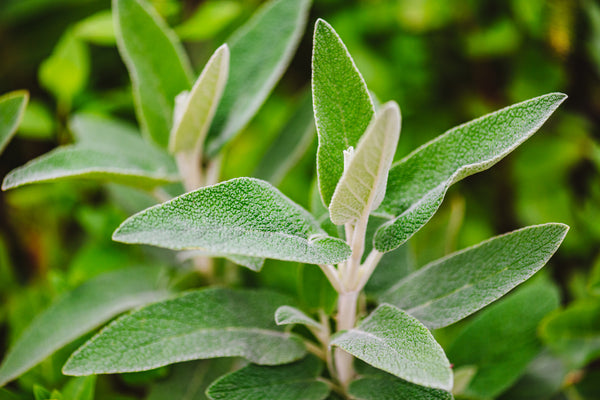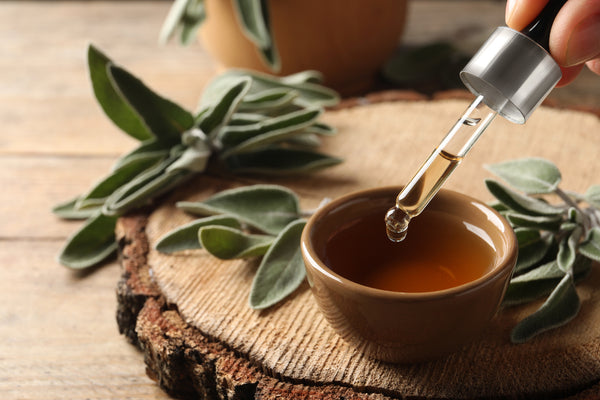
Sage Essential Oil- Benefits, Uses, and Origin
Sage essential oils come from a variety of plants under the genus Salvia. This plant group is comprised of hardy, evergreen shrubs that thrive in full sun and grow wild in most areas in the Mediterranean region. Sage is valued throughout history for its uses in medicine, magic, and meal preparations. The most common sage varieties include common sage (S. officinalis) and clary sage (S. pratensis).


Common sage is also known as True sage or Dalmatian sage, the latter due to the fact that most of the sage grows wild in the Croatian region of Dalmatia. It was later naturalized throughout Europe and North America.
Essential oils from common sage are made through the steam distillation of partially dried S. officinalis leaves. The process produces a colorless to yellow liquid with a warm camphoraceous odor and bitter taste. The oil is made of 50% thujone, camphor, pinene, and cineol.
Ancient Uses of Common Sage
Sage was once treated as a “cure-all” plant. The Romans revered it as sacred, while the Egyptians used sage as a treatment during the plague. Ancient folk placed sage under the influence of Venus and used it to aid contraception. Other traditions believe that eating a small amount of sage at a particular time would grant immortality. Sage was also a preferred tea in China and France for its healing and antioxidant properties.

Benefits of Using of Sage Essential Oil
Sage is widely popular as the main element burned for “spiritual cleansing” of certain beliefs and traditions. It is also the go-to spice for many cuisines nowadays, such as stuffing for the Thanksgiving turkey. But sage has more modern uses in addition to the annual holiday.
Improves and soothes skin
Sage is commonly used on the hair, skin, and nails. As a rinse, sage can improve the texture and tone of the hair, giving it a healthy shine. It is also infused in water to be used as toner to prevent oily skin. With tea tree, arrowroot, and basil oils, sage oil can also be used to prevent and treat fungal infection in toenails.
Defense against bacteria
Studies have shown that clary sage essential oil has anti-staphylococcus properties. It was also found to be potentially effective against other disease-causing bacteria such as E. coli, Salmonella typhi, and Bacillus subtilis. It is also used as mouthwash to treat gingivitis and sore throat. Sage is listed in the United States Pharmacopoeia as a treatment for bleeding and inflamed gums.
Supports memory

Sage has a long history of being used against mental decline. Modern studies on common sage show that the essential oil is a promising aid for improving memory and cognition. Along with Spanish sage, common sage oil has antioxidant and anti-inflammatory properties that may prevent the progress of dementia.
Source of antioxidants
Sage is a popular tonic and is the preferred tea in many cultures such as China because of its soothing and healing qualities. Sage has antioxidant properties that have been utilized by the food industry to improve the stability of oils that must be kept in storage for long periods of time.
Reduces anxiety and depression
Early research tested the efficacy of clary sage oil as an antidepressant on rats. The rats were injected with and allowed to inhale clary sage oil, which was found to serve as anti-stressor on the test animals. Further tests may be needed to conclude its efficacy as antidepressant on humans, but it has already been proven to calm the central nervous system and reduce anxiety. Rosemary and lavender oil can be blended to sage oil to create a calming environment around the home.
Promotes healthy menstrual and menopausal cycles
Sage can soothe spasms in smooth and skeletal muscles, making it useful against menstrual cramps and other muscular discomforts. It also has estrogenic substances that help regulate menstruation. Cold infusions serve as astringent and diuretic that help reduce night sweats in menopausal women and reduce milk flow in breast-feeding mothers.
Safety Tips and Precautions
While the use of sage essential oil has been proven to have several benefits, there are also some risks in taking them.
Sage oil should not be used during pregnancy, although small amounts of sage for culinary purposes is safe. People with epilepsy should also avoid using sage due to the oil’s thujone component, which may trigger convulsions. As essential oils tend to accumulate in the body, long-term use is not recommended.
It is important to note that it should be diluted before it can be applied to the skin. Three to five drops of essential oil can be mixed with an ounce of mineral oil or olive oil. Doing a skin patch test first can help determine one’s reaction to sage oil.
People who receive regular medication should talk to their doctor first before using sage as it can react with other drugs.
Parents are advised to keep sage oils away from children’s reach. It is also not advised to use sage oil for children below six years of age.
